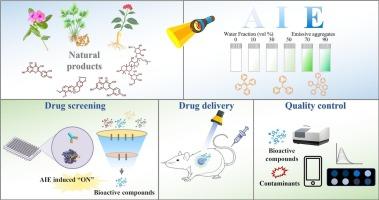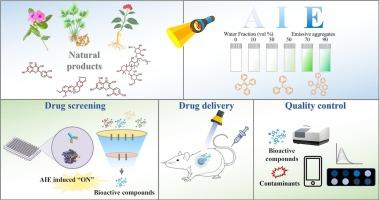Aggregation-induced emission in natural product research: Recent advances and future perspectives
IF 23.5
1区 化学
Q1 CHEMISTRY, INORGANIC & NUCLEAR
引用次数: 0
Abstract
Natural product research plays a crucial role in life sciences and chemistry, serving as a valuable reservoir for drug discovery and driving biomedical advancements. Fluorescence-based techniques, known for their high sensitivity to fluorescence signal changes, are widely applied in bioactivity screening and drug delivery. However, traditional fluorophores often suffer from aggregation-caused quenching (ACQ), significantly limiting their practical applications. In contrast, aggregation-induced emission (AIE) materials, a novel class of fluorophores, exhibit weak fluorescence in their dispersed state but emit strong fluorescence upon aggregation, effectively overcoming the ACQ limitation. This review highlights recent advances in AIE technology for natural product research, emphasizing its applications in bioactive compound screening, drug delivery, and quality control. AIE probes, owing to their high sensitivity, excellent selectivity, and rapid response, have emerged as ideal chemical and biological sensors in natural product research. Notably, these probes also hold considerable potential for development into portable devices for the on-site detection of natural products, including traditional Chinese medicines. These advancements would expand their applications, improving accessibility and utility, while advancing both medical and chemical sciences.


天然产物聚集诱导排放研究:最新进展和未来展望
天然产物研究在生命科学和化学中起着至关重要的作用,是药物发现和推动生物医学进步的宝贵资源。荧光技术以其对荧光信号变化的高灵敏度而闻名,广泛应用于生物活性筛选和药物传递。然而,传统的荧光团经常遭受聚集引起的猝灭(ACQ),极大地限制了它们的实际应用。相比之下,聚集诱导发射(AIE)材料是一类新型的荧光团,在分散状态下表现出弱荧光,但在聚集时发出强荧光,有效地克服了ACQ限制。本文综述了AIE技术在天然产物研究中的最新进展,重点介绍了AIE技术在生物活性化合物筛选、给药和质量控制等方面的应用。AIE探针具有灵敏度高、选择性好、反应速度快等特点,已成为天然产物研究中理想的化学和生物传感器。值得注意的是,这些探针也具有相当大的潜力发展成为便携式设备,用于现场检测天然产物,包括传统中药。这些进步将扩大其应用范围,改善可及性和实用性,同时促进医学和化学科学的发展。
本文章由计算机程序翻译,如有差异,请以英文原文为准。
求助全文
约1分钟内获得全文
求助全文
来源期刊

Coordination Chemistry Reviews
化学-无机化学与核化学
CiteScore
34.30
自引率
5.30%
发文量
457
审稿时长
54 days
期刊介绍:
Coordination Chemistry Reviews offers rapid publication of review articles on current and significant topics in coordination chemistry, encompassing organometallic, supramolecular, theoretical, and bioinorganic chemistry. It also covers catalysis, materials chemistry, and metal-organic frameworks from a coordination chemistry perspective. Reviews summarize recent developments or discuss specific techniques, welcoming contributions from both established and emerging researchers.
The journal releases special issues on timely subjects, including those featuring contributions from specific regions or conferences. Occasional full-length book articles are also featured. Additionally, special volumes cover annual reviews of main group chemistry, transition metal group chemistry, and organometallic chemistry. These comprehensive reviews are vital resources for those engaged in coordination chemistry, further establishing Coordination Chemistry Reviews as a hub for insightful surveys in inorganic and physical inorganic chemistry.
 求助内容:
求助内容: 应助结果提醒方式:
应助结果提醒方式:


